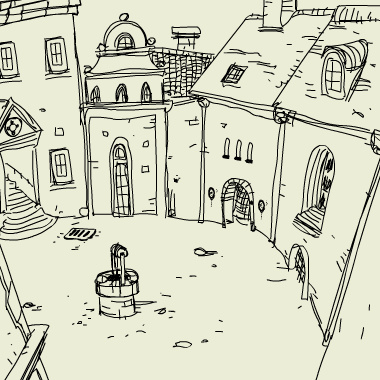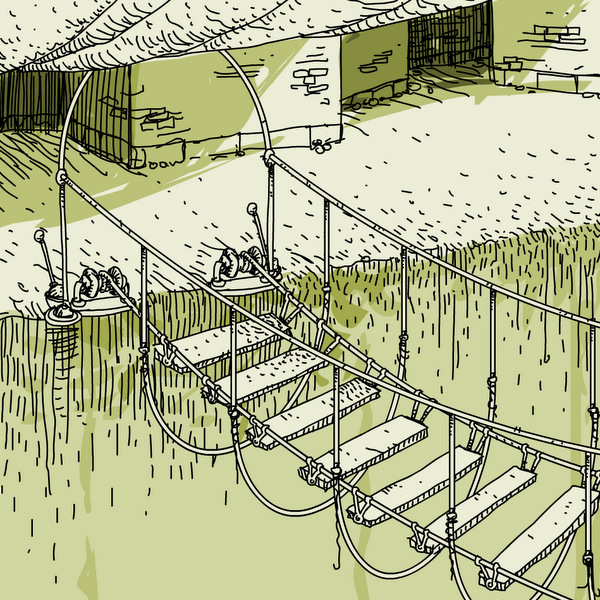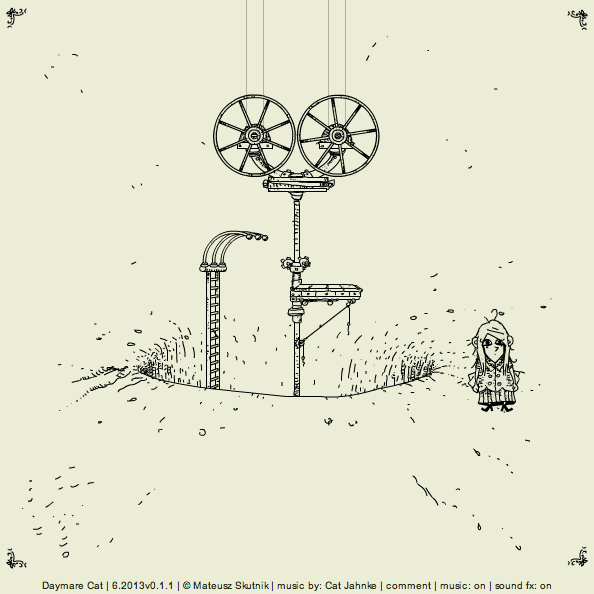Daymare Cat, Gameological review
July 13, 2013
 Where The Sidewalk Ends.
Where The Sidewalk Ends.
Daymare Cat aims to pique your curiosity with Shel Silverstein style.
“Never explain what you do,” said Shel Silverstein, likely the coolest bald poet of all time. “It speaks for itself. You only muddle it by talking about it.” Mateusz Skutul clearly took Silverstein’s maxim to heart when he created Daymare Cat. This black-and-taupe storybook of a game says very little to the player out loud beyond simple directions. Instead, it lets its strange world speak for itself.
As a young lady with a billowy dress and long ragged hair—as if she were pulled straight from a Neil Gaiman fan’s notebook—you’re trying to open a Persian-style door in a wind-blown, silent city. There’s no one else in town, and it isn’t clear how to open the door since there’s no keyhole, just a series of five pipes above it. As you wander through the city, jumping over bottomless pits, you’ll spot objects that are clearly tools to help move you closer to opening that door. Reaching them is a matter of inspecting the lovely, detailed architecture surrounding you. Details that seem like nothing but stylistic flourishes in the setting are often new paths, and discovering each one is delectable because there’s always something unique waiting on the other side. Through exploration and discovery, it soon becomes clear how that big, fancy door opens.
Daymare Cat’s success is how it tweaks curiosity then rewards indulging that curiosity with strange visions and song. More importantly, as Silverstein advised, it never explains what it does.
By Anthony John Agnello • July 1, 2013
Daymare Town 4 dev log #1 – Why does it take so long?
July 8, 2013
There is a pressing question hanging over my head and I want to address it today. Daymare Town 4. Why does it take so long?… Actually, this can be answered quite simply. Just take a look at these two pictures:
This is Daymare Town 1:

And this is Daymare Town 4:

I think those two pictures are quite self explanatory. It takes time, because DMT1 was done 6 years ago, and it was just a side sketch project. Since then it grew to become arguably my most important world and the best series of games. And while the submachine world is kind of closed in it’s mechanics and structure, the daymare world proved to be flexible and able to contain different gameplay architectures. Yes, latest addition of Daymare Cat kind of paved the way of evolution of this series. More on that in 2014.
Now. If you looked at those pictures above and still said to yourself: “So? Why does it take so long?…” – then I DARE you to watch this video and actually sit through it till the end. This is a stream of me creating the above picture.
After you’ve watched it – realize that this is just one location in a game that contains over 100 of them. True, not all of them are so complex, but any one that’s still not drawn COULD be, if you know what I mean. And this is not 9 to 5 job either. This is what people call creative work. It can’t be done on the clock.
So, after all this, if you’re still asking why does it take so long and WHEN the game’s going to be ready, then… uhm…. no, I’ve got nothing for you.
Or you can watch this.
nextgen dmt sample
July 2, 2013

DAMMIT! Why did I pick up the color brush today, instead of just sketching that new daymare game – as usual… Not that I’m on the fence about this one right now, not at all. DMT4 is coming up with the usual color pattern (meaning – pattern almost non existent), but…. this looks fine…
Oh well, I guess this is the POSSIBLE way the Daymare franchise might evolve in time. Move over Steam games, I’m coming.
Daymare Cat
June 24, 2013
10-year Anniversary Special Edition timestamp
reviews: Jay is Games | Imperium Gier | Nerds Raging | Indie Statik | Ecrans | Appelogen | Flash Mush
more reviews: Manitoba Music | TROAM | Gameological Society | StarBlog | Concept Hunter | Polityka
let’s plays: Sir Tap Tap | Indie Impressions
interview with Cat & me | Cat in Color
Daymare Cat is a gorgeously sketched exploratory platformer that feels like a simple adventure game. That feeling might be because Mateusz Skutnik has a rich history of point-and-clickers. The platforming here isn’t particularly challenging, but almost every hand-drawn scene is worth witnessing. The final reward in Daymare Cat is also something you can take with you anywhere. Thanks for that, Cat Jahnke!
[description by IndieGames]
Daymare Cat on Indie Impressions
June 23, 2013
Let’s grab our friends and go to very distant lands with today’s game: Daymare Cat by developer Mateusz Skutnik. Primarily an adventure game, Daymare Cat also has some very minor puzzles and simple platforming sequences, but the real draw here is the amazing art and music (music by Cat Jahnke) – almost like Alice in Wonderland we’ll explore a surreal, alien world with a lot of strange things going on in it while we search for records to open up a mysterious door. Try Daymare Cat for free at the link below and try the other work from this developer at the official site.
Daymare Cat, IG review
 O twórczości Mateusza Skutnika pisałam już w niedalekiej przeszłości, omawiając serie, nad którymi autor pracuje. Doczekaliśmy się nowej odsłony z uniwersum Daymare Town – przedstawiam Daymare Cat.
O twórczości Mateusza Skutnika pisałam już w niedalekiej przeszłości, omawiając serie, nad którymi autor pracuje. Doczekaliśmy się nowej odsłony z uniwersum Daymare Town – przedstawiam Daymare Cat.
Daymare Cat jest przygodową grą platformową, która wymaga od nas zbierania płyt winylowych. Wcielamy się w niej w młodą, roztrzepaną (chociaż kto w Daymare Town jest uczesany…) dziewczynę, która wyjątkowo raźnie i ochoczo skacze z cegłówek na parapety, z parapetów na unoszące w powietrzu platformy, eksploruje ciemne pomieszczenia i nory. Wszystkie zebrane przez nas przedmioty – zwyczajem innych gier przygodowych autorstwa Skutnika – pojawiają się w ekwipunku, czekając tylko na nasze ich użycie w odpowiedniej chwili.
Tych, którzy zaznajomieni są z wcześniejszymi tytułami Daymare Town poinformować muszę, że Daymare Cat nie jest typową grą z tej serii. Po pierwsze nie jest klasyczną grą przygodową typu point and click, po drugie jest nieco łatwiejsza, a po trzecie szelesty i powiew wiatru oraz chrupotanie nóżek maleńkich stworzeń gdzieś pod podłogą i w ścianach zastąpiła tu po części muzyka Cat Jahnke. Daymare Cat zachował jednak styl graficzny innych gier Skutnika – gra obfituje w najmniejsze szczegóły, a świat ponownie budują najmniejsze linie i punkciki, nadając mu wrażenie niebywałej kruchości.
Każdy może zagrać w Daymare Cat zupełnie za darmo. Miłej zabawy.
autor: Guga
Daymare Cat, Appelogen review
 Het spelletje Daymare Cat is al weer een pareltje van de hand van Mateusz Skutnik in de hem kenmerkende geschetste tekenstijl.
Het spelletje Daymare Cat is al weer een pareltje van de hand van Mateusz Skutnik in de hem kenmerkende geschetste tekenstijl.
Aan jou om de heldin Cat doorheen de wonderlijke straatjes van het stadje Daymare te loodsen op zoek naar vijf platen die uiteindelijk zullen zorgen voor de muzikale verlossing.
Alhoewel Daymare Cat een platform game is, is Mateusz er op meesterlijke wijze in geslaagd de nadruk te leggen op het oplossen van de puzzels en het verkennen van de locaties. En dat verkennen wordt puur genieten gelet op de zorg waarmee ieder scherm werd getekend.
Daymare Cat, Ecrans review
 Avec la course aux meilleurs graphismes que se livrent les jeux next-gen, on en oublierait presque le pouvoir de la simplicité. Mateusz Skutnik et ses univers sont là pour nous le rappeler. Après nous avoir enchanté avec ses Gnomes, rendu fous avec ses Submarines et en règle générale fait passer de très bons moments avec tous ses jeux Pastel Games, c’est la série des Daymare Town qui est de retour.
Avec la course aux meilleurs graphismes que se livrent les jeux next-gen, on en oublierait presque le pouvoir de la simplicité. Mateusz Skutnik et ses univers sont là pour nous le rappeler. Après nous avoir enchanté avec ses Gnomes, rendu fous avec ses Submarines et en règle générale fait passer de très bons moments avec tous ses jeux Pastel Games, c’est la série des Daymare Town qui est de retour.
Composé de trois épisodes principaux (le quatrième est à 40% terminé) et de trois spin-off épisodes secondaires, ces jeux d’aventure/plateforme/puzzle sont une expérience graphique à part entière. Univers en noir et blanc entre Tim Burton et Shel Silverstein, le décor fourmille de détails tant le dessin est précis et sans fioriture.
Ce dernier opus, Daymare Cat, nous place dans une ville cauchemardesque, distordue et vide. L’atmosphère est pesante, la sortie inconnue. La seule chose qui nous accompagne est le vent. Mais ici et là, bien cachés, reposent cinq disques que l’on devra placer sur des phonographes, chacun laissant entendre sa propre mélodie. Le jeu est court mais la difficulté est bien dosée. Enchanteur par ses graphismes et son ambiance, poétique et sombre à la fois, Daymare Cat est un vrai chef d’œuvre.
Par Corentin Courtois
Daymare Cat, Indie Statik review
 Close your eyes (but read the following words first). Now, imagine a place that you could go to in order to unwind, where colors leave you to admire just the outline of things, and a forlorn wind blows in the background. Everything has a great detail, and you can’t help but stare at the beauty in the tiniest of details. Cloths blow in the breeze, dirt tunnels are caressed by roots and the sky seems limitless.
Close your eyes (but read the following words first). Now, imagine a place that you could go to in order to unwind, where colors leave you to admire just the outline of things, and a forlorn wind blows in the background. Everything has a great detail, and you can’t help but stare at the beauty in the tiniest of details. Cloths blow in the breeze, dirt tunnels are caressed by roots and the sky seems limitless.
Does it look anything like Daymare Cat?
Mateusz Skutnik has clearly spent a lot of effort sketching out each and every screen in this puzzle-platformer, and the eloquent result is a daydream across a colorless and mostly silent world, across which you must travel to find freedom and solve the mystery that seems to lock you inside. The place appears to be a small, abandoned town, but there’s life in every nook and cranny due to the love that’s been etched into them by the creator. The world that is presented to you really feels as if you could lift up a stone and find every bit of dirt hiding underneath; it’s that detailed.
You won’t be spending too much of your time admiring the scenery, though, not after the initial few minutes of playing Daymare Cat. There are puzzles to be solved, most of which are pretty easy, much like the platformer sections. But what will hold you up in a few moments are the background passages and doors that aren’t made obvious, and so you’ll probably run past them a number of times, searching for what you’re missing without realizing the 2D plane and sketches are letting you down just a little.
I guess that’s a result of making a scene that looks so natural, despite its humble fantasy; nothing sticks out in particular. That’s only a minor problem that will only plague you in those moments, but won’t spoil the game come its end. You should remember it fondly.
Daymare Cat does feel more like an adventure game than anything else as a result of its progression through exploration, rather than challenging exploration or platforming. You mostly stick around the same areas and will backtrack when coming to a dead end quite often, and this is when you’ll start noticing that some of the backgrounds hold passages that you didn’t notice beforehand. Keys are one thing you collect for a while, but the main goal is to open a big door that requires you to find five records and play them on one of the gramophones around the place.
Once you’ve managed to do this, the game will come to a finish, and you’ll be given a link to download the song that you put together with the records for free. Wonderful! That art style and a free song? You’d be a fool to not play this one.
« Previous Page — Next Page »








